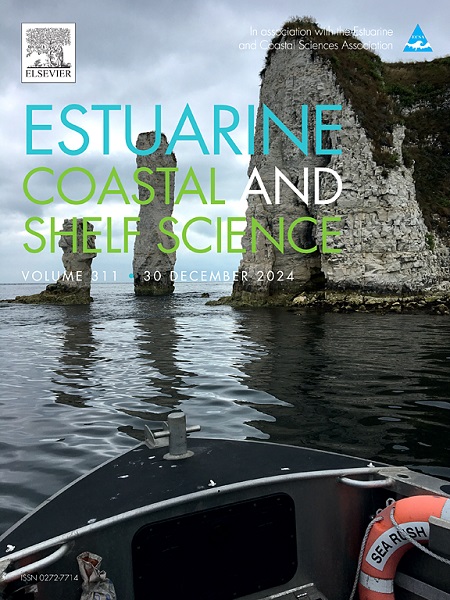Comparison of mangroves and other coastal vegetation in effectively trapping microplastics
IF 2.6
3区 地球科学
Q1 MARINE & FRESHWATER BIOLOGY
引用次数: 0
Abstract
Mangrove areas have been recognized as the most retentive zone for microplastics (MPs) originating from both terrestrial and marine sources. In this study, the level of MPs in the different parts of the mangrove species Avicennia marina, like leaves and roots as well as the sediment associated with its roots, was evaluated in the coastal mangroves of Tuticorin, Southeast Coast of India. The MPs were characterized by optical microscopy and ATR-FTIR. The mean abundance of MPs ranged from 0.6 to 1.2 items/cm2 (0.9 ± 0.3 items/cm2) in leaves, 1 ± 0.3 to 11 ± 6.3 items/kg (4.2 ± 3.8 items/kg) in roots, and 28 ± 5.2 to 53 ± 7.67 items/kg (30.33 ± 13.67 items/kg) in the root-associated sediment. The denser pneumatophore promotes entrapment and accumulation of MPs in sediment, which also enhances the absorption of MPs in pneumatophores due to direct environmental contact. The retention capacity of mangrove leaves for atmospheric MPs was compared with that of the leaves of terrestrial plants in the surrounding terrestrial environment. The specific leaf morphology of each species distinctly influenced the capacity for capture and retention. MP retention on the leaves of A. marina was greater due to the presence of waxy cuticles, small hairs, and salt crystals. In sediment, unlike leaves, the presence of diverse polymers was noted, while fiber-shaped MPs with polyethylene polymer were commonly found in leaves, roots, and sediment. This study concluded that mangrove plants have the potential to act as bioindicators of MPs. Based on this information, plant species with most MP-retaining abilities can be selected to build urban green infrastructure that lessens MP pollution.
红树林和其他沿海植被有效捕获微塑料的比较
红树林地区被认为是来自陆地和海洋的微塑料(MPs)最具保持性的区域。在这项研究中,在印度东南海岸的图蒂哥林沿海红树林中,对红树物种Avicennia marina不同部位(如叶子、根以及与其根相关的沉积物)的MPs水平进行了评估。通过光学显微镜和ATR-FTIR对MPs进行了表征。叶片中MPs的平均丰度为0.6 ~ 1.2项/cm2(0.9±0.3项/cm2),根中MPs的平均丰度为1±0.3 ~ 11±6.3项/kg(4.2±3.8项/kg),根相关沉积物中MPs的平均丰度为28±5.2 ~ 53±7.67项/kg(30.33±13.67项/kg)。更密集的气团促进MPs在沉积物中的捕获和积累,这也增强了由于直接环境接触而在气团中吸收MPs。比较了红树林叶片与周围陆生环境中陆生植物叶片对大气MPs的保留能力。不同树种的叶片形态对其捕获和滞留能力有明显的影响。由于蜡质角质层、小毛和盐晶体的存在,MP在叶片上的保留率更高。在沉积物中,与叶子不同,存在多种聚合物,而含有聚乙烯聚合物的纤维状MPs通常存在于叶子、根和沉积物中。本研究认为,红树林植物具有作为MPs生物指示物的潜力。在此基础上,可以选择保留MP能力最强的植物物种来建设减少MP污染的城市绿色基础设施。
本文章由计算机程序翻译,如有差异,请以英文原文为准。
求助全文
约1分钟内获得全文
求助全文
来源期刊
CiteScore
5.60
自引率
7.10%
发文量
374
审稿时长
9 months
期刊介绍:
Estuarine, Coastal and Shelf Science is an international multidisciplinary journal devoted to the analysis of saline water phenomena ranging from the outer edge of the continental shelf to the upper limits of the tidal zone. The journal provides a unique forum, unifying the multidisciplinary approaches to the study of the oceanography of estuaries, coastal zones, and continental shelf seas. It features original research papers, review papers and short communications treating such disciplines as zoology, botany, geology, sedimentology, physical oceanography.

 求助内容:
求助内容: 应助结果提醒方式:
应助结果提醒方式:


